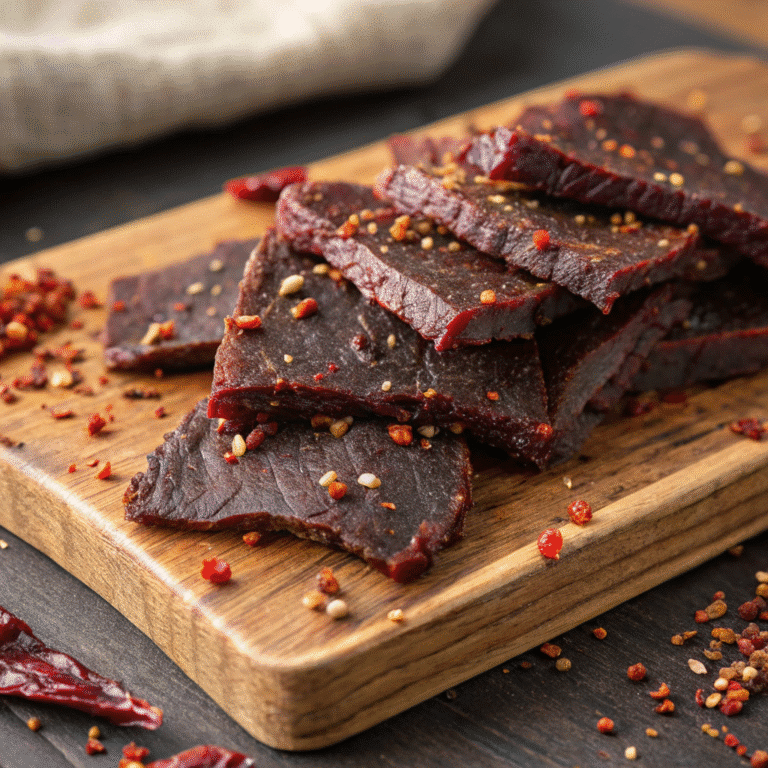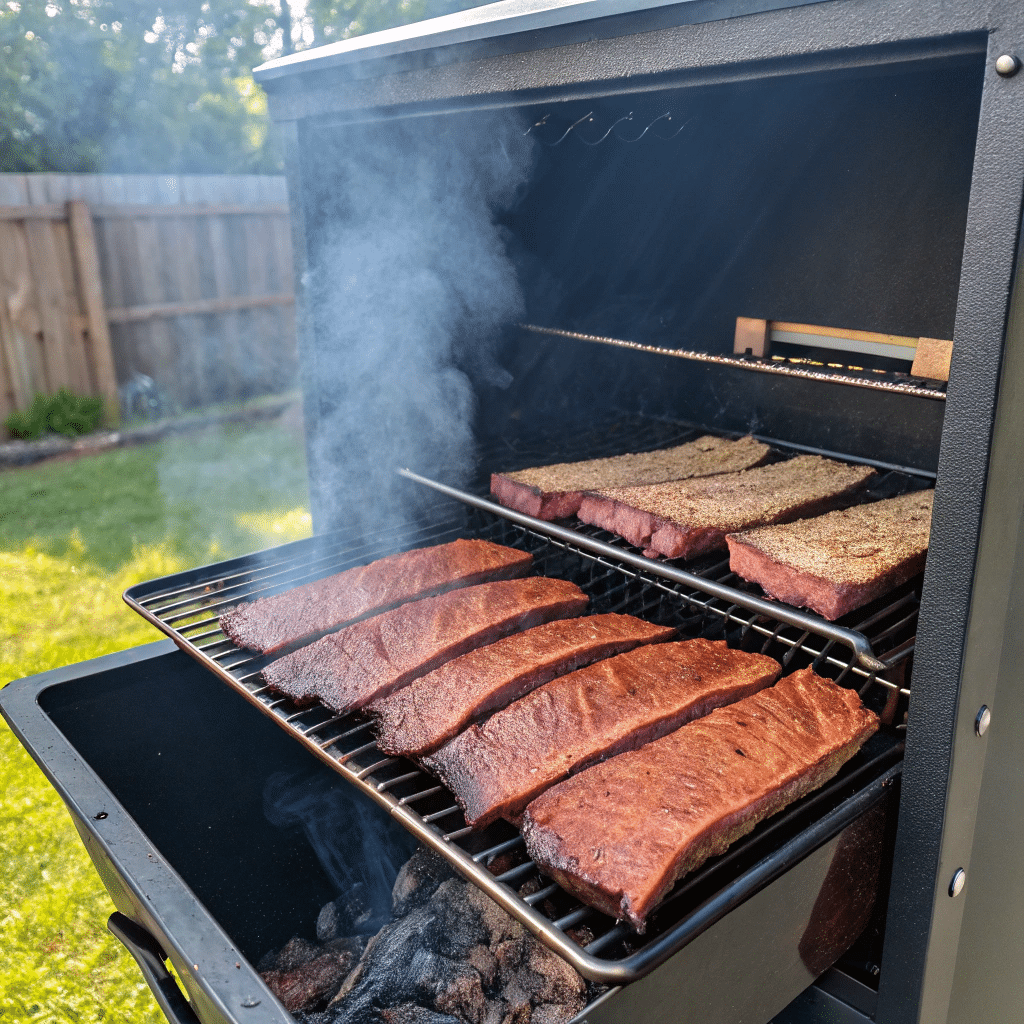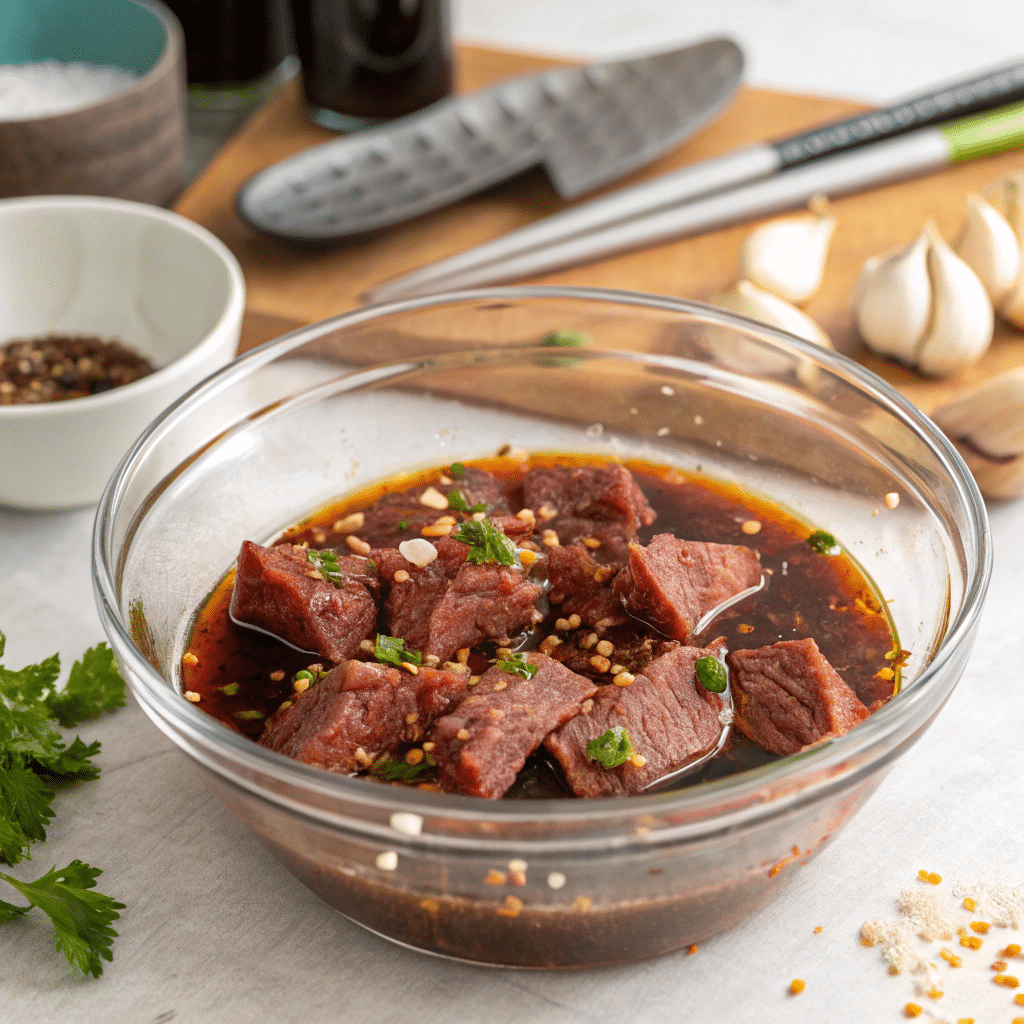Beef jerky is a snack staple loved for its rich flavor, high protein content, and grab-and-go convenience—but smoked beef jerky brings something even more special to the table. With a bold, smoky depth and tender chew, this jerky variety stands out from its dehydrated counterpart in more ways than one. Whether you’re looking to make it at home, understand its nutritional benefits, or discover where to buy the best options near you, this guide has it all.

In this comprehensive post, we’ll walk you through everything from how smoked jerky is made to how it compares with traditional beef jerky. You’ll explore the health advantages of smoked beef jerky, get a step-by-step homemade jerky recipe, and learn the best ways to store and enjoy it.
Plus, if you’re wondering where to buy high-quality smoked beef jerky or how to add it creatively to meals and snacks, we’ve got expert tips to help.
Print
Smoked Beef Jerky
Slow-smoked beef jerky, packed with deep smoky flavor and a tender, satisfyingly chewy texture.
- Total Time: 17 hours 20 minutes
- Yield: 12 servings 1x
Ingredients
2 lbs top round beef (or eye of round), thinly sliced
1/2 cup soy sauce
2 tbsp Worcestershire sauce
1 tbsp garlic powder
1 tbsp onion powder
1 tbsp freshly cracked black pepper
1 tsp smoked paprika
1 tsp brown sugar (optional)
1/2 tsp crushed red pepper flakes (optional, for heat)
Instructions
Trim all visible fat from the beef and slice into thin 1/8–1/4 inch strips against the grain.
In a large mixing bowl, combine soy sauce, Worcestershire, garlic powder, onion powder, pepper, paprika, brown sugar, and red pepper.
Add sliced beef to the marinade, mix well, cover, and refrigerate for 12–24 hours.
Preheat your smoker to 160°F. Use hickory, applewood, or your preferred wood chips.
Pat beef slices dry with paper towels and lay them flat on the smoker racks.
Smoke for 4 to 6 hours, flipping once midway. Jerky is done when it’s dry but still slightly pliable.
Let cool completely, then store in an airtight container or vacuum seal.
Notes
For extra tenderness, freeze beef 30 minutes before slicing.
Want it less salty? Cut soy sauce to 1/3 cup and replace with beef broth.
Add 1 tbsp liquid smoke to the marinade if not using a smoker.
- Prep Time: 20 minutes
- Marinate Time: 12 hours
- Cook Time: 5 hours
- Category: Snack
- Method: Smoking
- Cuisine: American
- Diet: Gluten Free
Nutrition
- Calories: 100 kcal
- Sugar: 1 g
- Sodium: 480 mg
- Fat: 4 g
- Unsaturated Fat: 2 g
- Protein: 13 g
- Cholesterol: 35 mg
Now let’s dive into the smoky, savory world of beef jerky done right.
Table of Contents
What Is Smoked Beef Jerky?
The Origins and Evolution of Beef Jerky
Jerky has been around for centuries. Originally developed by Indigenous peoples and early explorers, jerky was a survival food—lightweight, long-lasting, and rich in nutrients. Over time, it evolved from a necessity into a flavorful snack with countless variations. While most people are familiar with regular dehydrated beef jerky, smoked beef jerky adds a unique twist to this age-old tradition.
Defining Smoked Beef Jerky vs. Regular Jerky
So, what exactly makes smoked beef jerky different from regular jerky? The key lies in the preparation. Traditional jerky is dehydrated using low heat or a food dehydrator. It’s dried to protect the meat and remove any moisture.
Smoked beef jerky, on the other hand, is cured and then slowly cooked using natural wood smoke—usually from hickory, applewood, or mesquite. This smoking method imparts a bold, complex flavor to the meat—something a dehydrator simply can’t replicate. It also enhances preservation by introducing the natural antimicrobial benefits of smoke.
Traditional Smoking Methods Used in Jerky Making
Making smoked jerky the old-school way involves using a smoker or a smokehouse. The beef is first marinated in a blend of seasonings, then smoked at low temperatures—typically between 150°F and 180°F—for several hours.
Smoking often relies on a selection of well-loved wood types, such as:
| Wood Type | Flavor Profile |
|---|---|
| Hickory | Bold, smoky, slightly sweet |
| Applewood | Mild, fruity, subtly sweet |
| Mesquite | Strong, earthy, intense |
| Cherry | Sweet, mild, and balanced |
These traditional techniques produce a jerky that’s tender, flavorful, and incredibly satisfying. That’s why many people say smoked jerky isn’t just different—it’s better.
Why Choose Smoked Beef Jerky?
Unique Taste and Aroma Profile of Smoked Jerky
If you’ve ever bitten into smoked beef jerky, you know the flavor is in a league of its own. While dehydrated jerky can sometimes taste one-dimensional or overly salty, smoked jerky offers rich, nuanced flavors. The smoky aroma hits first—earthy, rich, and slightly sweet. Next, you get the bold, savory hit of cured meat, rounded out by delicate traces of woods like hickory or applewood.

This depth comes from the low-and-slow smoking process, which allows the natural fat in the meat to absorb flavor and moisture, keeping the jerky tender and flavorful. It’s this artisan-level attention to detail that makes smoked jerky a favorite among meat lovers and culinary purists.
How Smoking Preserves and Enhances the Meat Naturally
Smoking goes beyond flavor—it’s a time-honored method of preserving meat that’s been trusted for generations, it’s exposed to heat and smoke for hours, which removes moisture and inhibits bacteria growth. This means fewer artificial preservatives are needed compared to many mass-produced jerky brands.
Smoked beef jerky can also be made with fewer added sugars and nitrates, depending on the recipe. That makes it a cleaner option for those looking to avoid overly processed snacks. Plus, smoke from hardwoods contains natural antimicrobials and antioxidants that can help prolong shelf life and enhance safety.
So if you’re looking for a snack that’s delicious, clean, and naturally preserved, smoked beef jerky is a smart—and tasty—choice.
Health Benefits of Smoked Beef Jerky
Nutritional Value Compared to Regular Snacks
If you’re looking for a snack that keeps you full without wrecking your diet, smoked beef jerky delivers in a big way. Packed with protein and low in carbs, it’s a smarter alternative to sugary granola bars, salty chips, or high-calorie pastries. Just one ounce of beef jerky can pack approximately:
- 9–15 grams of protein
- 1–3 grams of carbs
- 0–3 grams of sugar (depending on recipe)
- 70–100 calories
Because smoked jerky undergoes a longer preparation process, it often uses less sugar and fewer artificial additives than mass-produced snacks. This makes it a better fit for low-carb diets, including keto, paleo, and high-protein eating plans.
You also get a concentrated source of iron and zinc—two essential minerals many people miss in modern diets. Unlike many snack bars that cause blood sugar spikes, jerky provides steady energy thanks to its high protein content.
Is Smoked Beef Jerky Good for Weight Loss or Keto Diets?
Absolutely. Thanks to its low carbohydrate count and high protein content, smoked beef jerky is ideal for those on weight loss journeys or following the keto diet. Protein helps you feel full longer, reduces cravings, and supports muscle maintenance during calorie deficits.
Plus, because jerky is portable and shelf-stable, it’s easier to stick to healthy eating when you’re on the go. No fridge? No problem. Just toss a few sticks of smoked jerky in your gym bag, lunchbox, or glove compartment and you’ve got a high-protein snack anytime.
Of course, not all jerky is created equal. Look for brands with minimal ingredients, low sugar, and natural smoke flavoring. Or better yet, make it at home so you control every ingredient.
How Smoked Beef Jerky Is Made
Key Ingredients and Best Cuts of Beef
Crafting smoked beef jerky begins with selecting the perfect cut of meat. The best choices are lean and grainy, such as:
- Top round
- Bottom round
- Sirloin tip
- Eye of round
These lean cuts help extend shelf life and give the jerky a satisfying chew without the greasy texture. The meat is then trimmed, sliced thin, and marinated in a mixture of salt, spices, and sometimes a little sugar or soy sauce to boost flavor.
Smoking Techniques: Wood Types, Temperature, Duration
Unlike dehydrated jerky, smoked jerky is cooked low and slow in a smoker. Here’s the quick breakdown:
| Smoking Element | Details |
|---|---|
| Temperature | 150°F to 180°F |
| Duration | 4 to 6 hours |
| Wood types used | Hickory, applewood, cherry, mesquite |
The smoke gradually seeps into the meat, gently drying it and layering it with bold, intense flavors. Different woods give different results—hickory for boldness, applewood for sweetness, mesquite for intensity.
Commercial vs. Homemade Smoked Beef Jerky
Commercial brands often rely on quick processing, artificial smoke flavors, and added preservatives. While they offer convenience, they may include excess salt, sugar, and additives.
Homemade smoked beef jerky, on the other hand, gives you full control. You choose the meat, the marinade, the type of wood, and the intensity of the smoke. The result? Cleaner ingredients and custom flavor.
If you like this recipe, check out some of my other favorite pasta dinners!
- How to Make Perfect Smoked Corned Beef Every Time
- Smoked Beef Short Ribs Made Easy: Step-by-Step Backyard BBQ Guide
How to Make Smoked Beef Jerky at Home
Step-by-Step Smoked Jerky Recipe (Simplified)
Making your own smoked beef jerky at home is easier than you think. Here’s a quick overview:

- Choose lean beef – Top round or eye of round work best
- Cut thin slices—roughly 1/8″ to 1/4″ thick—slicing across the grain.
- Marinate: Combine soy sauce, Worcestershire sauce, garlic, pepper, and a hint of brown sugar. Let the meat soak in the fridge for 12 to 24 hours
- Smoke low and slow: Heat your smoker to 160°F, choose hickory or applewood for flavor, and smoke the meat gently for 4 to 6 hours.
- Check for doneness: The jerky should be dry to the touch but still flexible enough to bend without breaking.
Allow it to cool completely before transferring it to a sealed container for storage.
Tools and Tips for Better Results
You’ll need:
- A reliable smoker or pellet grill
- Sharp knife or meat slicer
- Wire rack or grill grate for airflow
Pro tips:
- Before smoking, gently blot the meat dry using paper towels
- Rotate trays halfway for even drying
- Don’t over-smoke—it can turn bitter
Common Mistakes to Avoid
- Too thick slices → leads to uneven cooking
- Over-marinating → can make meat mushy
- Too much smoke → creates a burnt taste
- Using fatty cuts → causes spoilage
Where to Buy the Best Smoked Beef Jerky
Top U.S. Brands Selling Smoked Beef Jerky Online
You don’t have to make it yourself to enjoy great smoked beef jerky. Plenty of American brands specialize in small-batch or craft jerky with bold flavor and clean ingredients. Some of the top-rated include:
| Brand | Highlights |
|---|---|
| Old Trapper | Affordable, hardwood-smoked, widely available |
| Jack Link’s Smokehouse | Classic, reliable, and easy to find |
| People’s Choice Jerky | Small-batch, no sugar, natural smoke |
| Field Trip | Gluten-free, lower sodium options |
| Jerky.com | Dozens of unique smoke-flavor varieties |
These brands often use traditional wood-smoking techniques and offer gluten-free, low-sugar, and keto-friendly jerky varieties.
How to Find Locally Made Smoked Jerky Near You
Prefer supporting local makers? Many small towns and farmers markets sell locally made smoked beef jerky, often with richer flavor and better quality than mass-market options. Here’s how to find it:
- Search “smoked beef jerky near me” on Google Maps
- Explore nearby butcher shops, specialty meat markets, or barbecue spots.
- Visit weekend farmers markets or local festivals
- Explore local sections of grocery stores or co-ops
- Ask in community Facebook groups for recommendations
Local jerky usually has fewer preservatives and is often made fresh. Always ask about ingredients and how it’s smoked.
Smoked Beef Jerky Storage & Shelf Life
Does Smoked Beef Jerky Need Refrigeration?
It depends. If your smoked beef jerky is homemade or minimally preserved, it should be stored in the fridge after 3–5 days at room temperature. For store-bought jerky with preservatives and vacuum sealing, refrigeration isn’t necessary until the package is opened.
General rule:
- Unopened store-bought: Pantry-safe for up to 12 months
- Opened or homemade: Fridge-safe for up to 1–2 weeks
- Vacuum sealed homemade: Can last up to 2 months in fridge or 6 months in freezer
So yes—while jerky is shelf-stable, refrigeration extends freshness and keeps it safe longer, especially with homemade versions.
How to Extend Freshness and Avoid Spoilage
Want your jerky to last longer without losing flavor or texture? Follow these quick tips:
- Use vacuum-sealed bags or airtight containers
- Keep in a cool, shadowy spot, shielded from sunlight.
- Add a silica gel packet to absorb moisture (especially for homemade)
- Avoid opening and resealing the bag multiple times
- Freeze extra batches in small portions
Properly stored, your smoked jerky will stay chewy, flavorful, and safe to eat for weeks—or even months.
Creative Ways to Use Smoked Beef Jerky
Jerky in Recipes: Salads, Soups, and Trail Mixes
Smoked beef jerky isn’t just for snacking. You can add it to tons of everyday recipes for a flavorful, protein-packed boost. Here are some fun ideas:
- Salads: Chop jerky into small pieces and sprinkle over Caesar or chopped salads instead of bacon bits. Adds bold flavor and texture.
- Soups & stews: Add sliced jerky at the end of cooking for smoky richness—especially in bean-based soups or chili.
- Trail mix: Mix small jerky pieces with almonds, dried cranberries, and pumpkin seeds for a clean, high-protein snack.
These combos are perfect for meal prepping or fueling long hikes, road trips, or gym sessions.
Jerky as a Travel, Hiking, and Post-Gym Snack
Because it’s lightweight and doesn’t spoil quickly, smoked jerky is ideal for on-the-go fuel. Whether you’re hiking, camping, or just running errands, jerky fits easily into bags or glove boxes.
Key reasons it’s a smart snack:
- No refrigeration required (short term)
- High in protein, low in sugar
- Satisfies salty, savory cravings fast
Plus, it won’t spike your blood sugar like chips or candy, so it’s great post-workout.
Fun Snack Boards and Charcuterie with Jerky
Want to impress guests? Add smoked beef jerky to your next meat and cheese board. Pair it with:
- Sharp cheddar or smoked gouda
- Pickles, olives, and roasted nuts
- Dried fruits like figs or apricots
- A small ramekin of honey mustard or BBQ sauce
It adds a rustic, smoky flair that elevates any charcuterie setup.
Choosing the Right Smoked Jerky for Your Needs
Comparing Brands, Flavors, and Meat Sources
Not all smoked beef jerky is the same. When buying, look at:
- Meat type: Beef is common, but bison, turkey, and venison jerky are also smoked for leaner options.
- Flavor profiles: Choose from mild smoke, spicy, sweet, peppered, or garlic variations.
- Texture: Some prefer softer, chewy jerky; others like it drier and crisp.
Tip: Always read the ingredient list. The fewer additives and sugars, the better.
Smoked Jerky for Special Diets (Gluten-Free, Low-Sugar)
Many smoked jerky brands now cater to special diets:
- Keto-friendly: Low or no sugar, high protein
- Gluten-free: No soy sauce or wheat-based marinades
- Paleo: Simple seasonings, natural smoke, no preservatives
If you’re watching your sodium or sugar intake, opt for unsweetened jerky or make your own at home so you can control exactly what goes into it.
Final Buying Guide: Taste and Health in Balance
To enjoy the perfect balance of flavor and health, seek out:
- 100% grass-fed beef
- Natural hardwood smoke
- No nitrates, MSG, or added sugars
Try a sampler pack from trusted brands to find your favorite. And when in doubt, go homemade.
Frequently Asked Questions (FAQs) About Smoked Beef Jerky
What’s the difference between smoked beef jerky and regular jerky?
The main difference lies in the drying method. Regular jerky is typically dehydrated using low heat or a food dehydrator. Smoked beef jerky, however, is cooked slowly with wood smoke—giving it a deeper, richer flavor and added preservation benefits.
Is smoked beef jerky better for you than other snacks?
In most cases, yes. Smoked jerky is high in protein, low in carbs, and contains fewer processed sugars than chips, crackers, or candy. It also keeps you full longer, making it a smarter option for low-carb or high-protein diets.
Where can I find locally made smoked beef jerky near me?
You can often find local smoked jerky at butcher shops, meat markets, farmers markets, and local festivals. Searching “smoked beef jerky near me” on Google Maps or checking local Facebook groups can also help uncover small-batch sellers in your area.
Does smoked beef jerky require refrigeration?
If it’s homemade or opened, yes—it should be refrigerated to stay fresh. Unopened, store-bought smoked jerky can usually be stored in a pantry for months. Once opened, it’s best to refrigerate and consume within a week or two.
Conclusion: Why Smoked Beef Jerky Deserves a Spot in Your Pantry
Smoked beef jerky offers more than just bold flavor—it delivers nutrition, convenience, and versatility in every bite. Whether you’re looking for a healthier snack, a protein-packed hiking companion, or a savory addition to your charcuterie board, smoked jerky fits the bill.
From its naturally preserved texture to its smoky depth of flavor, it outshines regular jerky in taste and value. Plus, with the rise of gluten-free, low-sugar, and keto-friendly options, there’s a smoked jerky for everyone.
So whether you’re buying from trusted brands or smoking your own batch at home, this snack isn’t just satisfying—it’s smart, simple, and seriously delicious.
Follow us on Facebook at how to cooking recipes for daily recipe inspiration and kitchen tips.
